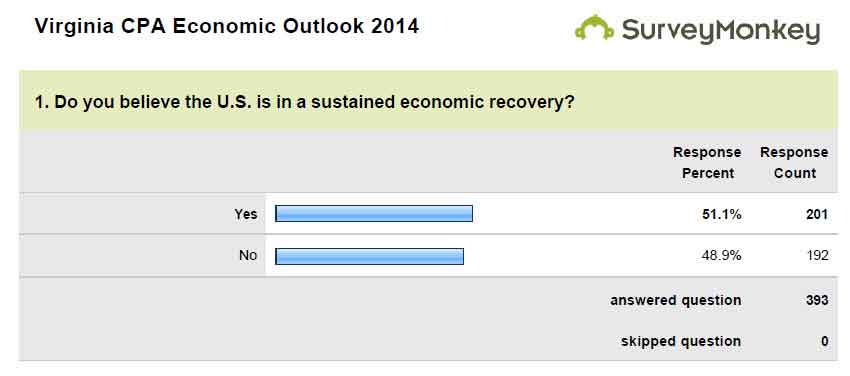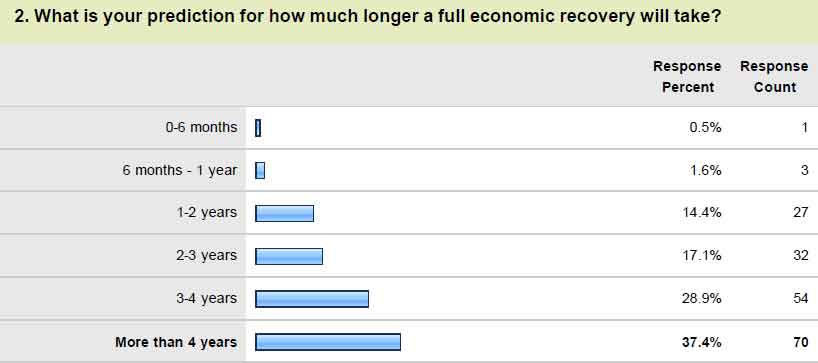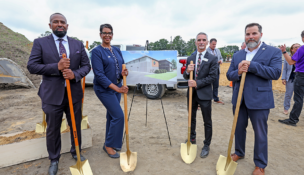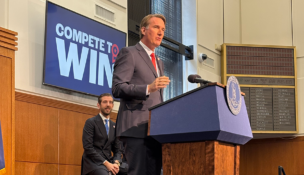Virginia CPAs increasingly believe economic recovery is sustainable
Virginia CPAs increasingly believe economic recovery is sustainable
 Virginia CPAs are more optimistic than they were two years ago that the national economy is in a sustainable recovery. Many, however, believe we are still more than four years away from a full recovery from the Great Recession.
Virginia CPAs are more optimistic than they were two years ago that the national economy is in a sustainable recovery. Many, however, believe we are still more than four years away from a full recovery from the Great Recession.
Those are two of the findings of the 2014 Virginia Economic Outlook Survey conducted in December by the Virginia Society of Certified Public Accountants. VSCPA polled its 7,900 members to get their opinions on the state of the economy and to find out what issues are most important to Virginia businesses. About 5 percent of the CPAs responded.
A slight majority of respondents (51.1 percent) said they believe the U.S. is in a sustained economic recovery. That response represents a jump of nearly 20 percentage points from the last VSCPA survey two years ago when more than two thirds of the CPAs said no sustained recovery was underway.
Nonetheless, a plurality of respondents in the new survey, 37.4 percent, think the U.S. is still more than four years away from a full recovery. By contrast, 32.2 percent of CPAs believed a full recovery was only one to two years away in the previous survey.
Looking at prospects for 2014, 35.7 percent, said they were “somewhat pessimistic” about the national economy, while 30.4 percent were “balanced” between optimism and pessimism, and another 25.5 percent were “somewhat optimistic.” Two years ago, nearly half of the respondents, 49.7 percent, were “somewhat pessimistic” in sizing up the economy in 2012.
CPAs also were divided in their outlook for Virginia’s economy in the new survey, with one third, 33.2 percent, saying they were “somewhat optimistic” about 2014, with 32.1 percent having a balanced view and 27.7 percent saying they were somewhat pessimistic.
Health-care costs were consistently cited by CPAs in the new survey as the biggest concern of Virginia businesses. A majority of respondents, 57.6 percent, said health care was the top financial problem facing business, up from 39 percent two years ago. In addition, 76.4 percent of the CPAs said the cost of health care is the top issue that needs to be addressed in the 2014 General Assembly session, which begins on Jan. 8.
By contrast, the effects of sequestration, automatic cuts to the federal budget, drew a mixed response from the CPAs in the new survey. Virginia is considered vulnerable to federal budget swings because defense spending represents a big part of the state economy. A plurality of respondents in the new survey, 48 percent, said sequestration would have a major effect on Virginia’s economy in 2014, while 47.1 percent described sequestration as having a marginal effect on the Old Dominion.
The CPAs’ response to this issue, however, varied widely by region. Fifty-six percent of respondents in Central Virginia and 50 percent in Southwest Virginia said sequestration would have a marginal effect on the state. In Northern Virginia, opinion was divided, with 48.7 percent saying the budget cuts would have a marginal effect and 47 percent saying they would be a major economic factor.
Concern about sequestration was most pronounced in Southeast Virginia, home of major military installations in Hampton Roads. Sixty-seven percent of the respondents there said sequestration would have a major effect on Virginia’s economy.
Southeast Virginia CPAs also cited infrastructure challenges, as well as health-care costs, as among the most pressing issues facing the state. Like Northern Virginia, the region has been seeking solutions for traffic congestion for years.
All regions of the state overwhelming described Virginia’s business climate as good compared with neighboring states. Pluralities of respondents in Northern, Southeast and Central Virginia say the commonwealth’s pro-business climate has had the greatest impact in attracting or retaining companies. Southwest Virginia, however, cited the availability of an educated workforce as the biggest issue there.
A majority of respondents in the new survey, 54.5 percent, work in public accounting, with the rest working in business, industry and other sectors. Forty-nine percent represent businesses with more than 50 employees. Another 44.8 percent represented businesses with two to 50 employees, and 6.2 percent represented sole proprietorships.
n
















